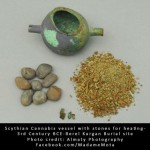 By Adrienne Mayor (Regular Contributor)
By Adrienne Mayor (Regular Contributor)
Galloping for miles on tough ponies, hunting, making war, marauding, and plundering, hot and dry in the summer and bitterly cold in the winter —life on the Scythian steppes was dirty, dusty work for nomad men and the women known to the ancient Greeks as Amazons. How did the saddle-sore Amazons and their male companions relax and tend to their bodies? For Scythians, bathing was a special occasion usually undertaken as a purification before funerals in the spring.
The Greek historian Herodotus (ca 450 BC) describes the Scythian-style toilette. Their unusually refreshing sauna sounds like a New Age spa treatment.
First the Scythians wash their heads with soap and water. But, notes Herodotus, they never wash their bodies this way. In order to cleanse their bodies, they fix in the ground three long sticks inclined towards one another to make a tipi-like booth. Large pieces of woolen felts are stretched over the poles, overlapping to fit as close as possible. Inside the tipi is a large stone bowl of red-hot stones. The men and women enter the felt tipi and toss handfuls of hemp-seeds onto the red-hot stones. (Cannabis grows wild on the steppes.) The smoke produces such a delightful vapor as no Grecian vapor-bath can exceed, remarks Herodotus. The Scythians shout for joy, and this intoxicating steam- bath serves them instead of a water-bath.
Then Herodotus divulges a recipe for an Amazon beauty mask.
The women make a mixture of cypress, cedar, and frankincense. They pound these ingredients into a paste on a rough stone, adding a little water. When this substance takes on a smooth, thick consistency, they cover their faces, and indeed their whole bodies, with the paste and retire for the night. When they remove the plaster on the next morning, comments Herodotus, a sweet odor is imparted to them and their skin is clean and glossy.
Today, all three of these ingredients are used in perfumes, cosmetics, and pharmaceuticals. Cedar and cypress trees grow at high altitudes, as easily available to the Scythian nomads as local cannabis plants. Fragrant cedar and cypress oils have antiseptic qualities, helpful in fighting infection. Both are astringents for reducing oily skin, employed today against acne and dermatitis.
Small lumps of frankincense, the aromatic resin of Boswellia trees of the Arabian desert, would have been a precious trade commodity, available from merchants on the Silk Routes across Central Asia. It appears in ancient Egyptian recipes for beauty masks for toning and smoothing scars. Frankincense has antiseptic, anti-inflammatory properties, and is found in modern beauty products reputed to rejuvenate aging skin.
Adrienne Mayor is a Research Scholar in Classics and History of Science, Stanford University. She is the author of The Amazons: Lives and Legends of Warrior Women across the Ancient World (2014) and The Poison King: The Life and Legend of Mithradates, Rome’s Deadliest Enemy, a nonfiction finalist for the 2009 National Book Award.
This post first appeared at Wonders & Marvels on 6 September 2012.
